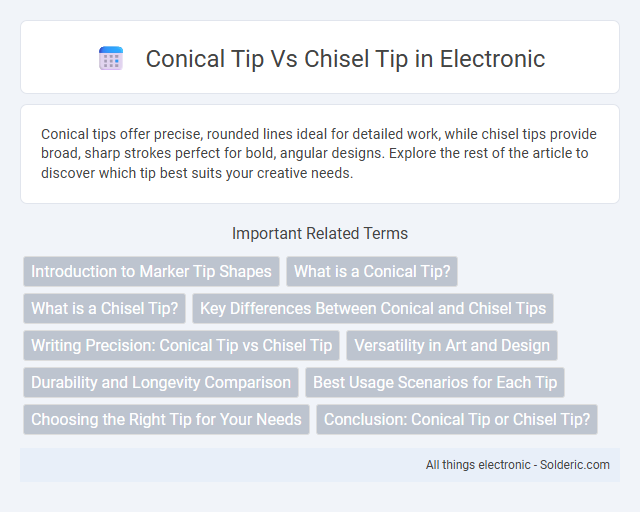Conical tips offer precise, rounded lines ideal for detailed work, while chisel tips provide broad, sharp strokes perfect for bold, angular designs. Explore the rest of the article to discover which tip best suits your creative needs.
Comparison Table
| Feature | Conical Tip | Chisel Tip |
|---|---|---|
| Shape | Rounded, tapered point | Flat, angled edge |
| Line Variation | Uniform, consistent lines | Varied line widths (thin to thick) |
| Best Use | Precise writing and detailed drawing | Bold strokes, calligraphy, highlighting |
| Control | High precision | Flexible stroke styles |
| Common Applications | Technical pens, markers, fine liners | Highlighters, markers, calligraphy pens |
| Durability | Moderate; tip wears evenly | High resistance to wear due to broad edge |
Introduction to Marker Tip Shapes
Marker tip shapes significantly influence precision and application in writing and drawing. A conical tip provides a rounded, fine point ideal for detailed work and smooth lines, while a chisel tip features a flat, angled edge suited for creating both broad strokes and sharp edges. Understanding these differences helps you select the right marker tip shape to enhance your creative projects or professional tasks.
What is a Conical Tip?
A conical tip features a rounded, pointed end that allows for smooth, consistent lines and precise control, making it ideal for detailed work and fine strokes. This tip shape is commonly used in markers and pens for versatile applications including drawing, writing, and coloring. Compared to a chisel tip, a conical tip provides more flexibility in line width depending on the pressure and angle applied.
What is a Chisel Tip?
A chisel tip is a flat, angled marker tip designed to create both broad and fine lines by adjusting the angle at which it is held. It is ideal for calligraphy, highlighting, and detailed artwork due to its versatility in producing varied line widths. This tip contrasts with conical tips, which offer a consistent, rounded line better suited for uniform strokes.
Key Differences Between Conical and Chisel Tips
Conical tips feature a rounded point ideal for precise, detailed work, while chisel tips have a flat, angled edge designed for broad, sharp lines and filling larger areas efficiently. The conical tip offers better control for fine lines and intricate designs, whereas the chisel tip excels in creating varying line thicknesses and bold strokes. Your choice depends on whether you need accuracy or versatility in line width for your project.
Writing Precision: Conical Tip vs Chisel Tip
Conical tips offer fine writing precision with smooth, consistent lines ideal for detailed work and everyday writing. Chisel tips provide variable line widths, enabling bold strokes and fine details by adjusting the pen angle, suitable for calligraphy and artistic applications. The choice between conical and chisel tips depends on whether the priority is uniform precision or dynamic line variation.
Versatility in Art and Design
Conical tips offer smooth, consistent lines ideal for detailed illustrations and subtle shading, enhancing versatility in fine art and graphic design. Chisel tips provide broad strokes and sharp edges, making them perfect for calligraphy, bold lettering, and dynamic designs. Artists and designers often choose between these tips based on the need for precision or expressive coverage in their creative projects.
Durability and Longevity Comparison
Conical tips generally offer shorter durability due to their softer, rounded edges which wear down more quickly with frequent use. Chisel tips are known for greater longevity because their flat, angled shape maintains structural integrity longer, resisting deformation during heavy applications. The harder material composition often found in chisel tips further enhances their durability compared to conical counterparts.
Best Usage Scenarios for Each Tip
Conical tips are ideal for detailed and precise work such as writing, drawing fine lines, and creating intricate designs due to their pointed shape that offers controlled ink flow. Chisel tips excel in bold strokes, highlighting, and calligraphy, providing versatility with broad and narrow lines achieved by varying the angle of application. Your choice between conical and chisel tips depends on whether your priority is fine detail or dynamic, expressive lines.
Choosing the Right Tip for Your Needs
Selecting the right tip depends on the application: conical tips provide precision and control for detailed work, while chisel tips offer broad, consistent coverage ideal for highlighting and bold strokes. Conical tips excel in tasks requiring fine lines and intricate designs due to their pointed shape, whereas chisel tips are preferred for creating sharp edges and filling larger areas efficiently. Consider the specific use case and desired effect to determine whether superior accuracy or expansive coverage is more important.
Conclusion: Conical Tip or Chisel Tip?
Conical tips offer precision and control, making them ideal for detailed work and consistent application in tasks like drawing or soldering. Chisel tips provide a broader, versatile edge that enhances coverage and efficiency, especially for tasks requiring bold lines or spreading materials quickly. Your choice depends on whether you prioritize fine detail with a conical tip or broader strokes and speed with a chisel tip.
conical tip vs chisel tip Infographic

 solderic.com
solderic.com